-
Posts
800 -
Joined
-
Last visited
-
Days Won
5
Content Type
Profiles
News and Information
Tutorials
Product Reviews
Supplier Listings
Articles
Guitar Of The Month
Links and Resources
Forums
Gallery
Downloads
Posts posted by orgmorg
-
-
Screwed it up pretty good yesterday.

I was drilling for the ground wire between the bridge and the control cavity, and went trhough the back. I had plotted it out pretty well on paper, so I'm guessing the drill bit flexed in the hole and took a turn downward.
I probably could have patched it, but I never would have been happy with it.
Thought about doing an inlay, but who inlays the back of a guitar?
People who screw up the back, that's who.

So what is something that is commonly seen on the back of a guitar?
A control cover
So I routed it for a battery compartment cover
There won't actually be a battery, or even a cavity, so it is just a dummy cover, but it is much more appropriate than an inlay.
Why, you ask?
Have a look under the cover:

And who knows, maybe someday I will want to install a preamp.
Anyhoo.. I also got more work done on the bridge:
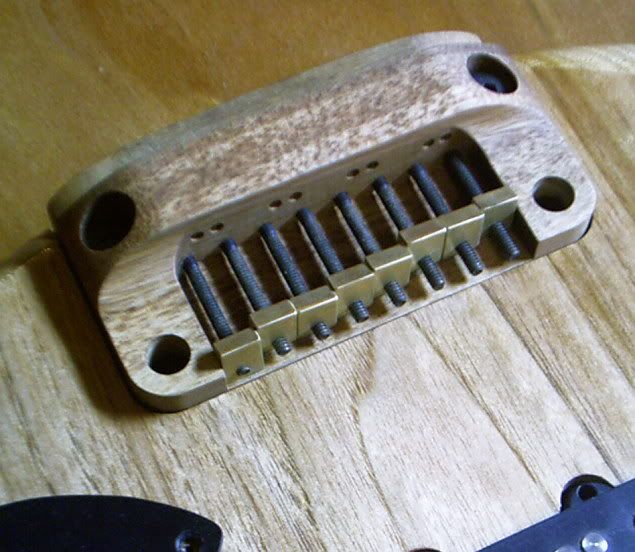
It is basically two pieces of wood. The first ( top pic ) is the main body which holds the saddles, and in which the strings are anchored.
The second ( link ) is a cap that covers the heads of the allen bolts, thus holding them captive, eliminating the need for springs.
The four big holes along the bottom of the cap are just for the screws that hold it to the main body.
The eight holes above them are for inserting an allen key to adjust the saddles. ( intonation )
Above that, recessed into the main body, are the holes for the strings. Next step is to put a thin copper plate in there with a ground wire soldered to it, which will go down thru a hole in the bottom of the bridge, into the hole I srewed up earlier.
The whole unit is height adjustable via 4 bolts, here is a cross section , front to back, showing how this works:
The bridge is height adjustable, as a whole unit, basically suspended between the two pairs of bolts in stepped holes. The ones in the back hold it down, while the ones in the front hold it up, as the strings attempt to torque the whole thing forward. The tapered backs of the flathead bolds and the round tops of the roundhead bolts engaged in the ledge created by the stepped holes allow it to pivot.
In addition the front of the bridge bears against the wall of the cavity in the body it is recessed into.
Edit: changed extra pics to links
-
And yes, you can use it over the Danish oil.
-
If you mean the thing in the lower left corner, that is the volume control pot. Above and to the right of that is the output jack. Above and to the left of the jack (barely visible) is a 5 way 4 pole strat type switch, for different combinations of coils.
-
Those ARE cool tuners. Nice choice, they will look perfect on that guitar!
-

The pickguard is just plain black plastic. That's reflections you are seeing.
Still working on the finish.
I usually like to have a veneer on a headstock to match the body, but I didn't want to cover up the cherry with butternut. I think it will be busy enough looking with the figured cherry and 8 black tuners of two different sizes. I couldn't think of anything to add that wouldn't clutter it up too much.
Savin' the bridge for last.

-
Thanks!
Now, to really tie it all together, here's a shot with the pickguard fitted:
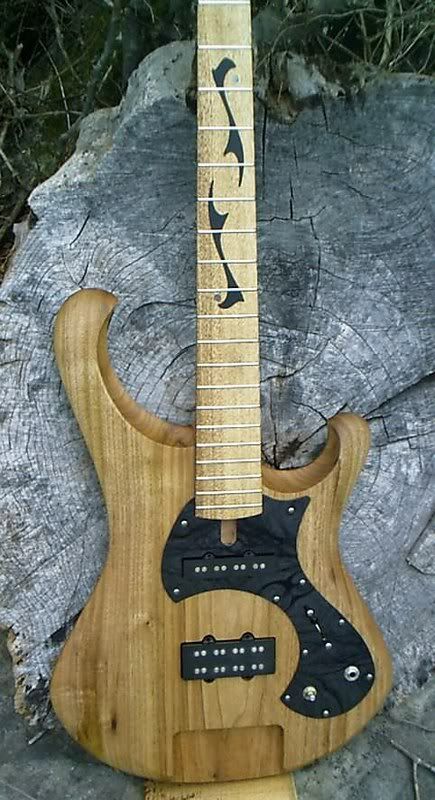
-
Well, Most folks prefer a router for cutting truss rod channels, but if you really want to do them on a tablesaw, you don't need a dado blade. The channel is usually only 1/4" wide ( except for the martin style box trussrod ) so a few passes with a normal blade works fine. Also, that way you can make sure you get the right width by gauging each pass. With the stacked dado, youhave to fuss with the shims to get it right, and run the risk of getting it too wide right off the bat.
-
I'm doing an oil finish on the whole thing. Starting with danish oil ( Watco ) rubbing it in with 0000 steel wool, then it will get a few coats of tru-oil, followed by many coats of Minwax wipe-on poly.
Thanks again for all the compliments, I'm glad everyone is digging this as much as I am.
And Happy Birthday, Jason!

-
Cool!
Looks nice!
Wanna tell us a bit about it?
The guitar, that is- don'wanna know about the hair.

-
Ah, I see it now. I thought the middle part would have encircled the 12, but whatever works.
I started out designing it that way, but it left too much room at the top of the board, and I really didn't want more inlay than this on it. This puts it more in proportion, and gives reference to the main positions.
Got the neck glued in last night.
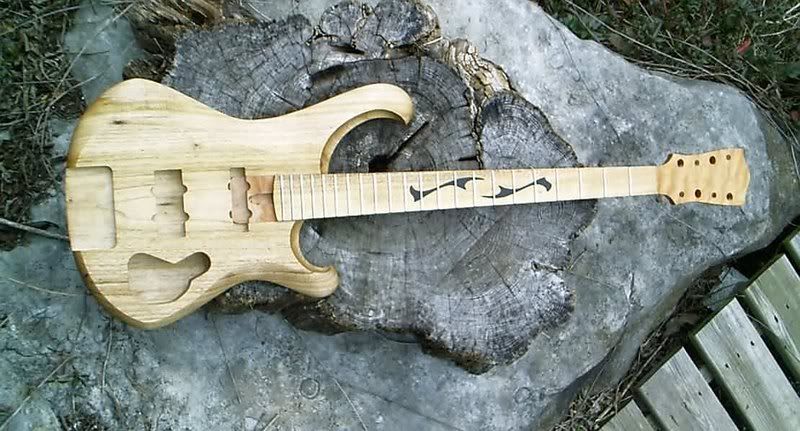
Edit: changed pic to link
-

Thanks for all the positive response!
Xanthus- the inlay stretches from the 5th fret to the 12th, with the wider portions being on the 5,7,9 and 12
Inisheer- just something from my twisted mind.

 Kinda inspired by tribal style tattoo work and art nouveau design.
Kinda inspired by tribal style tattoo work and art nouveau design.Bassisgreat- Yeah, it's a strange wood. I've been trying to figure out a way to incorporate it into something for a while. When you see the whole thing together, it will make sense.
I'm on a kick of using less commonly used woods right now, especially locally harvested stuff. Persimmon is cool partly because it is in the same genus as ebony ( Diospyrus ) It has a real slick feel to it as well. I may try using it for a fretless board one of these days.
-
Thanks!
 I'm liking it!
I'm liking it! Just wish I had a halfway decent camera.
I don't have a heck of a lot of persimmon of any reasonable quality ( It tends to contain a lot of defects ) , but if you really need a piece, and have something interesting to swap, let me know.
-
Got the inlay done:
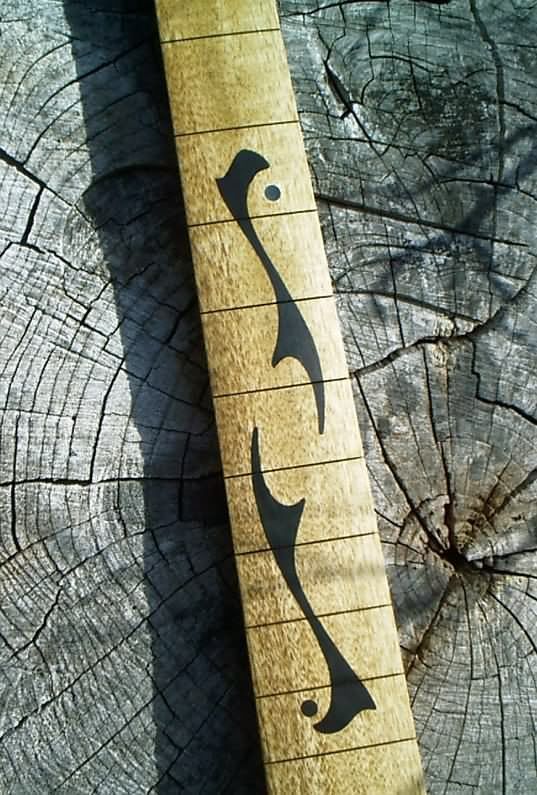
Neck is carved, too. Now on to fretting.

-
I think you will be much better off keeping the tablesaw. You will find a lot more uses for it than the mitersaw.
-
Ya, it's bright! almost too bright for me, even, and I like loud colors. It will darken up quite a bit, probably get at least as dark as the mahogany.
The saddles I will probably leave brass colored, unless I find a blackening/antiquing solution I like.
Controls will be real simple, probably just a volume knob. That's the way I usually like it.
The pickup has 5 conductors, though. I'll have to look up the specs and see if there is a wiring option for coil cut or phasing.
-
Thanks, the tuners will be black, and the bridge will be one I am making from the same wood as the fingerboard, with adjustable brass saddles. Pickup will be an EMG HZ35 passive.
-
-
so is it like a 6 string piccollo; i dont know the definition of baritone;
what gauge are the strings?
Well, I don't really know the definition of a piccolo bass, myself. A baritone is generally anything tuned higher than a bass and lower than a guitar. This is tuned a full octave below a guitar, like a bass, with the high B and E strings as well.
String gauges on this one are 90-20, and scale length is 29 7/16"
Thanks for the compliments on the shape, I'm liking it as well. It's one I've been playing with for a while, and finally have a version that seems to work. I had originally intended to use it for the 8 string bass I am building, but I had a feeling it might be a bit neck heavy as a long scale, especially with 8 tuners. So I did a quick-n-dirty scrapwood mockup with a repositionable thru-neck, and sure enough, the head dove straight to the floor when I strapped it on. 30" scale and 6 tuners was what it needed to make it balance and feel comfortable. I started looking at strings, and found a set for the Musicman Silhouette 6 string bass, which is 29 5/8" scale. They cost only a tad more than a set of guitar strings, too. starting from the 3rd fret position on my 35" fret template gave me 29 7/16" so I figured I'd give that a try.
-
Not at all, but it will still be good practice.
Mahogany actually will carve a lot nicer, since the grain is finer and more even. It's harder than pine, but works easier.
-
Absolutely. Go for it! Cherry is a wonderful wood to work with.
-
+1 on the finish! I was wondering what that was going to look like.
Only thing I don't like is the angled humbucker, but I never like those, that's just me.
Other than that, it looks fantastic. Congrats on a successful first build!!

-
This one is going to be along the lines of the old Gibson EB-6, which was a 6 string bass, with a 30.5" scale, and string spacing not much wider than a regular guitar. It would almost be considered a baritone guitar by today's standards, but it is tuned a full octave below a standard guitar. I am widening the spacing a little bit, but it will still be very narrow compared to a typical bass, 2 1/2" spread at the bridge, and nut width of 1 3/4"
The body is done. Back is one piece mahogany ( 30 year old Gibson dumpster score
 )
)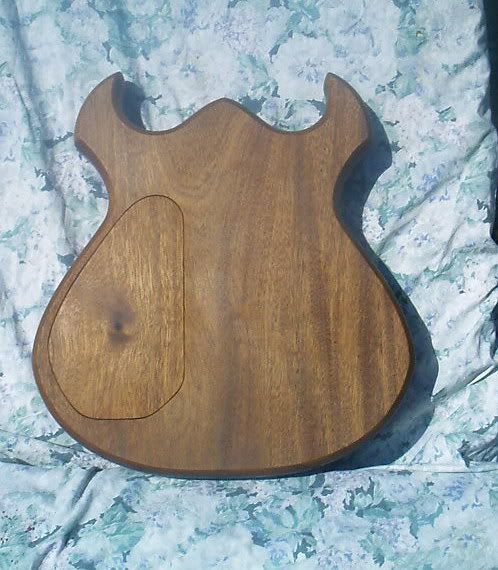
It is chambered, with a 4 piece mesquite bookmatch top.
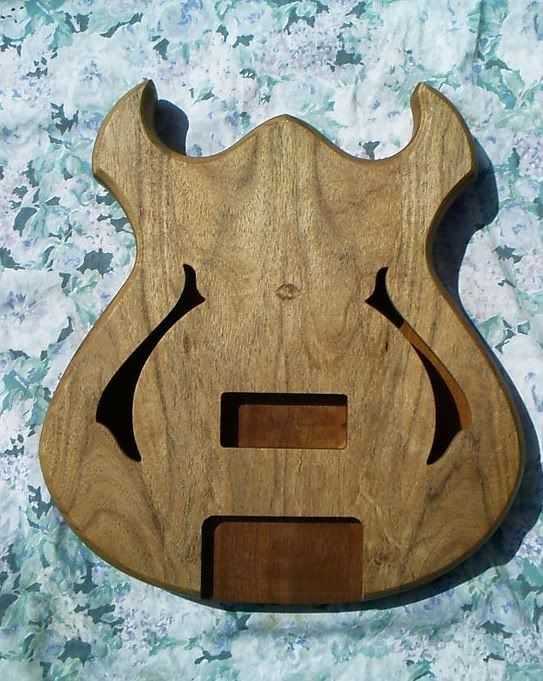
The neck will be padauk, with an osage orange fingerboard. ( warning- sunglasses may be required )
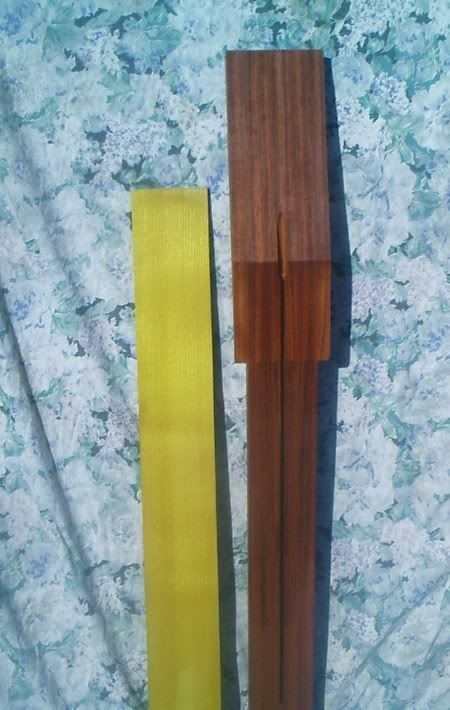
The osage will darken considerably, so it won't be nearly so garish.
The bridge will be made of it as well.
I've wanted one of these ever since I had the chance to see an EB-6 ages ago. They are one of the rarest Gibsons, and command astronomical prices these days, especially the ones with the semihollow, es-335/EB-2 style body. Most were SG-shaped, like the EB-0/EB-3 Mine is a wierd mutation of the latter, only marginally resembling it, but using a piece of wood that in theory could have become one.
-
The floor's looking good, too!

-
Your wish is my command.

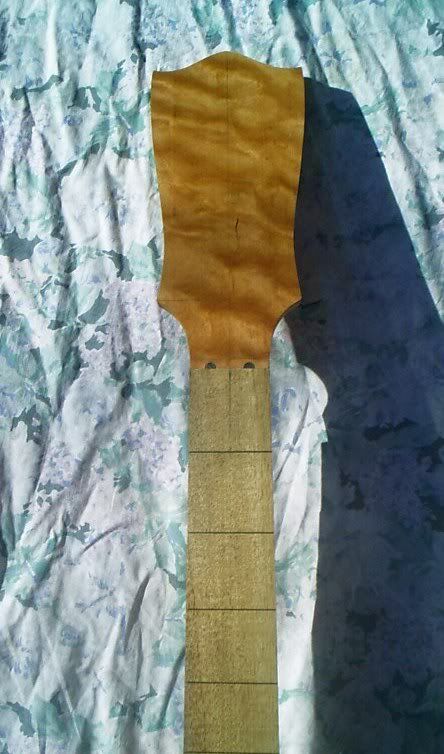
I'm thinking I might do some inlay on it, with ebony.



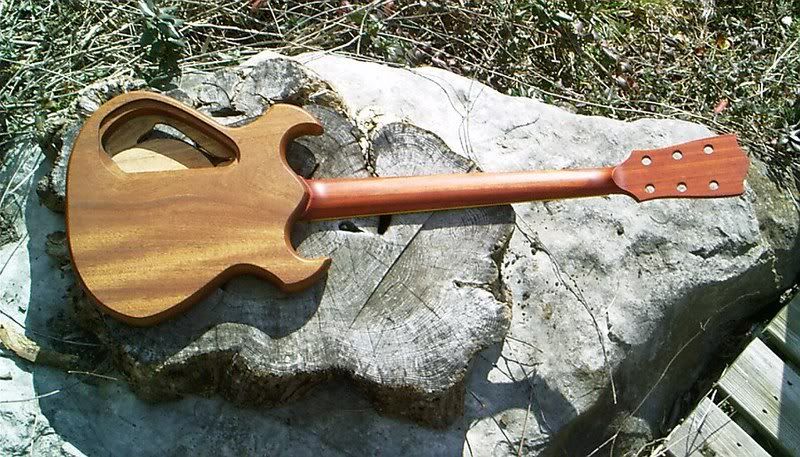
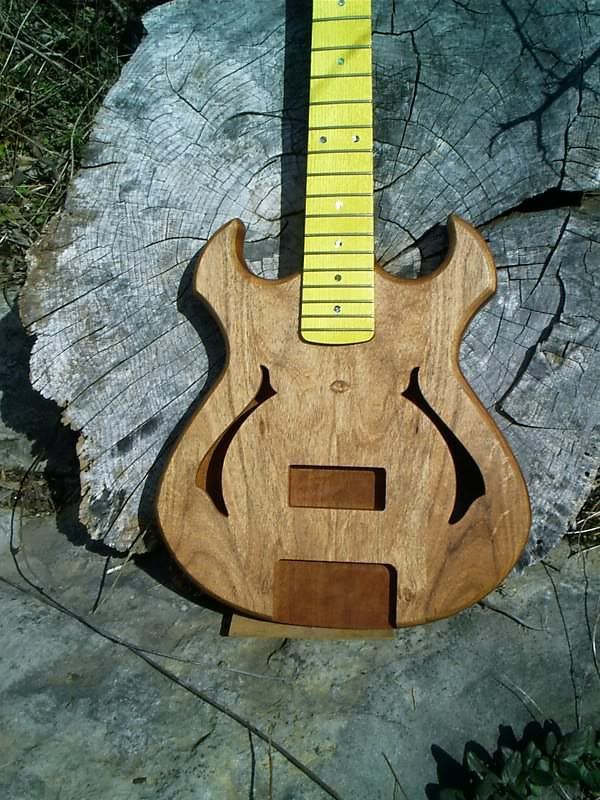
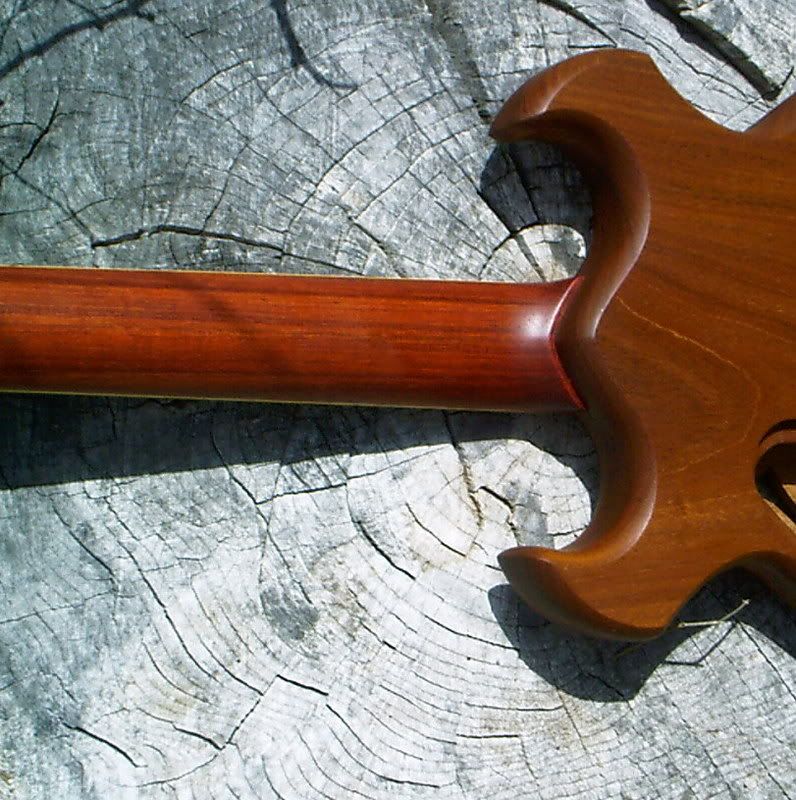
Butternut 8 String Bass
in In Progress and Finished Work
Posted · Edited by orgmorg
Yes, quite a bit of trial and error, part of which became the cutaway view above.
They are persimmon, like the fretboard.
About 1/4" I doubt I will even have to go half that, though.
Yes, the recess has a round bottom, and the ball ends nest in it side by side.
Remember, the strings are paired- a fundamental and an octave per course, so each string actually sits near the edge of it's saddle
-
Yes, and yes. Threaded brass inserts
Yes, hence the inserts.
No, the only movement of the screws is to set the intonation, and that will probably only be done once. Also, the persimmon is very dense and hard.
Because I am not that ambitious ( or superstitious )
)
We shall see. That is a valid concern, especially with the strings on the edges of the saddles. If it becomes a problem, I can swap saddles around so that the top bevels alternate. That way, each pair will be aligned so that they hold each other up.
Edit: No, actually I would have to make four new saddles to do that.
Glad to know I'm not the only one who screws up like this.